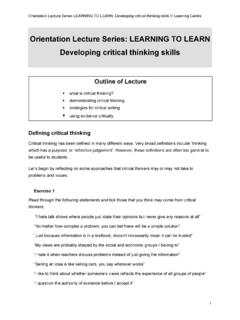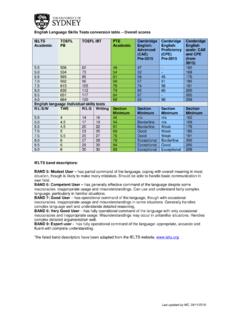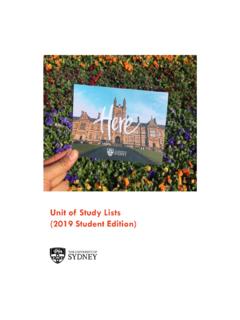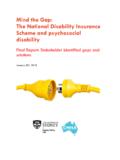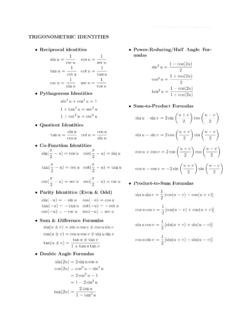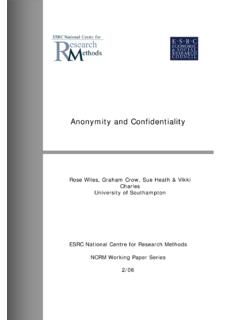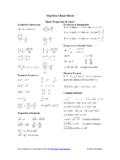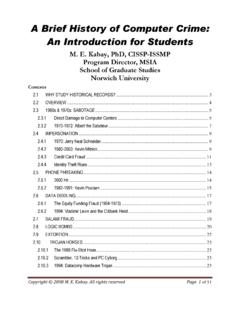Transcription of Trigonometric Identities Peggy Adamson
1 Mathematics Learning CentreTrigonometric IdentitiesPeggy Adamsonc 1986 University of SydneyContents1 How to use this book .. Introduction .. Objectives .. Pretest .. 22 Relations between the Trigonometric functions23 The Pythagorean identities44 Sums and differences of angles75 Double angle formulae116 Applications of the sum, difference, and double angle formulae127 Self assessment138 Solutions to exercises14 Mathematics Learning Centre, University of Sydney11 How to use this bookYou will not gain much by just reading this booklet. Have pencil and paper ready to workthrough the examples before reading their solutions. Doallthe exercises. It is importantthat you try hard to complete the exercises on your own, rather than refer to the solutionsas soon as you are IntroductionThis unit is designed to help you learn, or revise, Trigonometric need to know these Identities , and be able to use them confidently.
2 They are usedin many different branches of mathematics, including integration, complex numbers best way to learn these Identities is to have lots of practice in using them. So weremind you of what they are, then ask you to work through examples and exercises. We vetried to select exercises that might be useful to you later, in your calculus unit of ObjectivesBy the time you have worked through this workbook you should be familiar with the Trigonometric functions sin, cos, tan, sec, csc and cot, and with therelationships between them, know the Identities associated with sin2 + cos2 =1, know the expressions for sin, cos, tan of sums and differences of angles, be able to simplify expressions and verify Identities involving the Trigonometric functions, know how to differentiate all the Trigonometric functions, know expressions for sin 2 , cos 2 , tan 2 and use them in simplifying trigonometricfunctions, know how to reduce expressions involving powers and products of Trigonometric func-tions to simple forms which can be integrated.
3 (x, y) Mathematics Learning Centre, University of PretestWe shall assume that you are familiar with radian measure for angles, and with thedefinitions and properties of the Trigonometric functions sin, cos, tan. This test is includedto help you check how well you remember in radians angles in degrees angles ofi. 4ii. 3 are the values 2 the graph ofy= Relations between the Trigonometric functionsRecall the definitions of the Trigonometric functions by means of the unit circle,x2+y2= =ycos =xtan =yxThree more functions are defined in terms of these, secant (sec), cosecant (cosec or csc)and cotangent (cot).sec =1cos (1)csc =1sin (2)cot =1tan (3)Mathematics Learning Centre, University of Sydney3 The functions cos and sin are the basic ones. Each of the others can be expressed in termsof these. In particulartan =sin cos (4)cot =cos sin (5)These relationships are Identities , not equations.
4 An equation is a relation between func-tions that is true only for some particular values of the example, the relation sin = cos is an equation, since it is satisfied when = 4, butnot for other values of between 0 and .On the other hand, tan =sin cos is true for all values of , so this is an relationships (1) to (5) above are true for all values of , and so are Identities . Theycan be used to simplify Trigonometric expressions, and to prove other Identities . Usuallythe best way to begin is to express everything in terms of sin and the function cosx sinxcosx= thatsin + tan csc + cot = sin tan .To show that an identity is true, we have to prove that the left hand side and theright hand side are different ways of writing the same function. We usually do thisby starting with one side and using the Identities we know to transform it until weobtain the expression on the other + tan csc + cot =sin +sin cos 1sin +cos sin =(sin cos + sin )1 + cos sin cos =sin2 (1 + cos )cos (1 + cos )(x, y)B OA1xyMathematics Learning Centre, University of Sydney4=sin2 cos = sin tan Exercises sec + tanx1 + +1cot 1=1 + tan 1 tan +1sinx+ cosx= cscxc.
5 (1 + tanx)sinxsinx+ cosx= The Pythagorean identitiesRemember that Pythagoras theorem states that in any right angled triangle, the squareon the hypotenuse is equal to the sum of the squares on the other two the right angled triangle OAB,x= cos andy= sin ,socos2 + sin2 = 1(6).Mathematics Learning Centre, University of Sydney5 Remember that cos2 means (cos )2= cos cos .Two other important Identities can be derived from this both sides of (6) by cos2 we obtaincos2 cos2 +sin2 cos2 =1cos2 ie 1 + tan2 = sec2 .If we divide both sides of (6) by sin2 we getcos2 sin2 +sin2 sin2 =1sin2 ie cot2 + 1 = csc2 .Summarising,cos2 + sin2 = 1(6)1 + tan2 = sec2 (7)cot2 + 1 = csc2 (8) the expressionsec2 sec2 sec2 1=sec2 tan2 =1cos2 sin2 cos2 =1sin2 = csc2 . that1 2 cos2 sin cos = tan cot .tan cot =sin cos cos sin =sin2 cos2 sin cos =1 2 cos2 sin cos .Mathematics Learning Centre, University of Sydney6 Exercises + cotxb.
6 (1 sin2t)(1 + tan2t) + cos sec tan +cos 1sec + tan . cos4 =1 2 cos2 tanxsinx+ + sec tan =tan sec that you used these Identities in finding the derivatives of tan, sec, csc thatddx(sinx) = cosxandddx(cosx)= (tanx)=ddx sinxcosx =cosxcosx sinx( sinx)cos2x=cos2x+ sin2xcos2x=1cos2x= (cotx), (secx), (cscx). OBA OA'B' Mathematics Learning Centre, University of Sydney74 Sums and differences of anglesA number of useful Identities depend on the expressions for sin( + ) and cos( ).We shall state these expressions, then show how they can be ( + ) = sin cos + cos sin (9)cos( + ) = cos cos sin sin (10)sin( ) = sin cos cos sin (11)cos( ) = cos cos + sin sin (12)The expressions for sin( + ), sin( ) and cos( + ) can all be derived from theexpression for cos( ). We derive that expression at the two diagrams below containing the angle ( ). We assume is greaterthan.
7 We draw and in standard position(ie from the positivex-axis), and let Aand B be the points where the terminalsides of and cut the unit is the point (cos ,sin ).B is the point (cos ,sin ).We draw the angle in standardposition and let A be the point whereits terminal side cuts the unit is the point (cos( ),sin( )).B is the point (1,0).The triangles OAB and OA B are congruent, since triangle OA B is obtained by rotatingOAB until OB lies along thex-axis. Therefore AB and A B are equal in that the distance between two points P(x1,y1) and Q(x2,y2) is given by the formula(PQ)2=(x2 x1)2+(y2 y1) the distance AB is given by(AB)2= (cos cos )2+ (sin sin )2= cos2 2 cos cos + cos2 + sin2 2 sin sin + sin2 =2 2 cos cos 2 sin sin . _O(x,y)(x, y) _2 Mathematics Learning Centre, University of Sydney8 The distance A B is given by(A B )2= (cos( ) 1)2+ (sin( ))2= cos2( ) 2 cos( )+1+sin2( )=2 2 cos( ).
8 These distances are equal so2 2 cos( )=2 2 cos cos 2 sin sin cos( ) = cos cos + sin sin .From this we can derive expressions for cos( + ), sin( + ) and sin( ).In order to do this we need to know the following results:sin( )= sin cos( ) = cos andsin( ) = cos( 2 )cos( ) = sin( 2 ).Nowcos( + ) = cos( ( ))= cos cos( ) + sin sin( )= cos cos sin sin Mathematics Learning Centre, University of Sydney9sin( + ) = cos[ 2 ( + )]= cos[( 2 ) ]= cos( 2 ) cos + sin( 2 ) sin = sin cos + cos sin sin( ) = sin( +( ))= sin cos( ) + cos sin( )= sin cos cos sin .These formulae can be used in many different sin(a+b) + sin(a b).sin(a+b) + sin(a b) = sinacosb+ cosasinb+ sinacosb cosasinb= 2 sin( 2+ ) = cos using the addition ( 2+ ) = sin 2cos + cos 2sin =1 cos +0 sin .= cos .Exercises (A+B) sin(A B) (A+B) + cos(A B) (A+B) cos(A B) Learning Centre, University of ( ) = sin ( )= cos ( 2 ) = sin ( 2+ )= sin.
9 Expressions for tan(A+B) and tan(A B) follow in a straightforward way. Try to derivethem for yourself (A+B)=sin(A+B)cos(A+B)=sinAcosB+ cosAsinBcosAcosB sinAsinB=sinAcosBcosAcosB+cosAsinBcosAco sBcosAcosBcosAcosB sinAsinBcosAcosB=tanA+ tanB1 (A B)=sin(A B)cos(A B)=sinAcosB cosAsinBcosAcosB+ sinAsinB=sinAcosBcosAcosB cosAsinBcosAcosBcosAcosBcosAcosB+sinAsin BcosAcosB=tanA tanB1 + (A+B)=tanA+ tanB1 tanAtanB(13)tan(A B)=tanA tanB1 + tanAtanB(14)Exercises thatcot( + )=cot cot 1cot + cot . =2 3and = 3, write down values of tan , tan and verify the expres-sions for tan( + ) and tan( ).Mathematics Learning Centre, University of Sydney115 Double angle formulaeExpressions for the Trigonometric functions of 2 follow very easily from the shall summarise them and ask you to derive them as an 2 = 2 sin cos (15)cos 2 = cos2 sin2 (16)cos 2 = 2 cos2 1(17)cos 2 =1 2 sin2 (18)tan 2 =2 tan 1 tan2 (19)ExampleShow cos 2 = 2 cos2 2 = cos( + )= cos cos sin sin = cos2 sin2 = cos2 (1 cos2 )= 2 cos2 the rest of the expressions 2 1 cos 2.
10 Sin 2 1 cos 2 =2 sin cos 1 (1 2 sin2 )=2 sin cos 2 sin2 = cot .Exercises + sin( 2 2x)1 sin( 2 2x). + cos 2 sin 2 . + sinA cos 2 AcosA+ sin Learning Centre, University of Sydney126 Applications of the sum, difference, and double an-gle formulaeA number of relations which are very useful in integration follow from the Identities insections 4 and (17) cos 2 = 2 cos2 1 it follows thatcos2 =12(1 + cos 2 )(20)and from (15) cos 2 =1 2 sin2 it follows thatsin2 =12(1 cos 2 )(21)These Identities are very useful in integration. For example cos2 d = 12(1 + cos 2 )d = 2+14sin 2 +Cso you need to be expert in using them to simplify that sin2xcos2x=18(1 cos 4x).sin2xcos2x=12(1 cos 2x) 12(1 + cos 2x)=14(1 cos22x)=14(1 12(1 + cos 4x))=14(12 12cos 4x)=18(1 cos 4x).Exercises .Mathematics Learning Centre, University of Sydney13We showed earlier that sin(A+B) + sin(A B) = 2 sinAcosB,sosinAcosB=12(sin(A+B) + sin(A B)).
